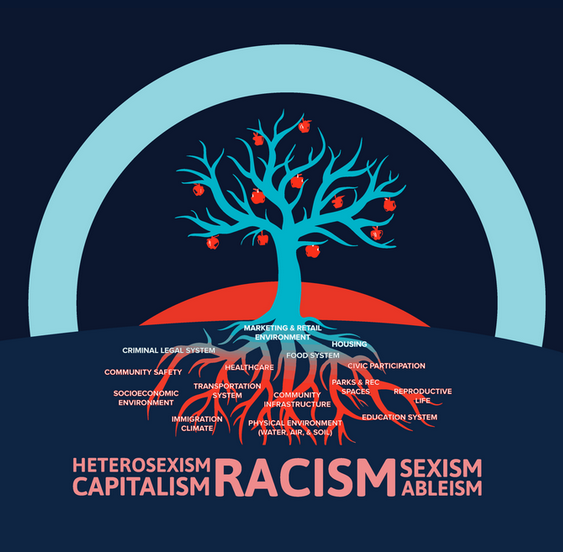
Share On Social!
Where we live and the conditions that we live in impact our health and life outcomes.
This concept is widely called the Social Determinants of Health (SDOH).
Unfortunately, when people live in and experience negative conditions, it can lead to poor health outcomes and disparities, particularly among Latinos and other marginalized communities.
In their new SDOH framework, the Praxis Project highlights the root systems of oppression that have led to health disparities for communities of color.
“Many traditional SDOH frameworks lack the explicit naming of systems of oppression that cause disparities in health determinants. In an effort to incorporate these systems of oppression and to highlight the root causes of these determinants from a justice and community power perspective, The Praxis Project created this visual representation,” according to the Praxis Project’s website.
The framework illustrates how systems of oppression lead to health disparities through graphics that depict different parts of a tree with roots.
We can address health disparities and advocate for equity by strengthening communities and fostering social cohesion.
“Building community power, including basebuilding and community organizing, however, remain largely untapped and represent an area of great opportunity for advancing racial and health equity,” according to the Praxis Project’s website.
Let’s dive into the SDOH, learn about the new framework, and explore how to build equitable, cohesive communities.
What are the Social Determinants of Health?
Social determinants of health (SDOH) are the conditions in the environments where people are live that affect a wide range of health and quality-of-life outcomes, according to the U.S. Department of Health and Human Services (HHS).
Examples of determinants from HHS include:
- Safe housing, transportation, and neighborhoods
- Racism, discrimination, and violence
- Education, job opportunities, and income
- Access to nutritious foods and physical activity opportunities
- Polluted air and water
- Language and literacy skills
Praxis Project also describes these additional social determinants of health:
- Justice System
- Civic Participation
- Connections with Neighbors
- Healthcare
- Hope & Efficacy
- Immigration Climate
- Marketing and Retail environment
- Reproductive Life
- Transportation
- Valued cultures and identities
Determinants like these can lead to health disparities, particularly for Latino and Black communities.
For example, people without access to grocery stores with healthy foods – often Latinos – are less likely to have good nutrition. This raises their risk of health conditions like heart disease, diabetes, and obesity — and even lowers life expectancy relative to people who do have access to healthy foods.
It’s important to note that just providing the healthy options and choices isn’t enough to eliminate the disparities. Instead, policymakers and leaders need to improve the negative conditions to improve quality of life.
What is Praxis Project’s Framework on the Social Determinants of Health?
The Praxis Project created a framework based on a tree and its roots to symbolize how systems of oppression lead to disparities, particularly for Latino and Black communities.
The following are the different stages in the framework:
- The Soil
The soil symbolizes the inequities that lead to health disparities.
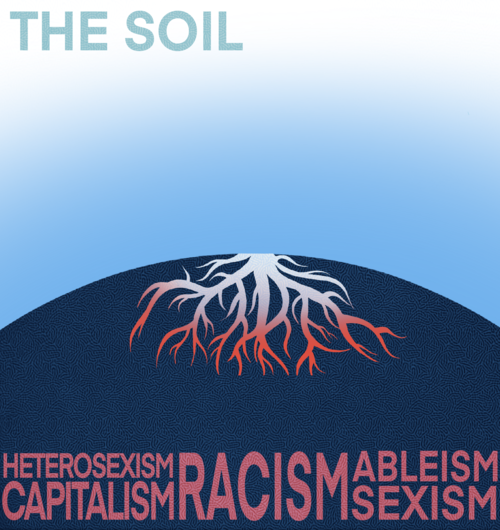
“Racism, ableism, sexism, capitalism, and heterosexism are examples of systems at the foundation of U.S. institutions, reinforced through policies and legislation, that have led to historically oppressed groups facing the brunt of inequity. These systems disturb all facets of the human condition and are deeply intertwined,” according to the Praxis Project’s website.
- The Roots, Trunk, and Fruit
The roots and trunk of the tree symbolize the determinants that are “infected” by the malignant soil.
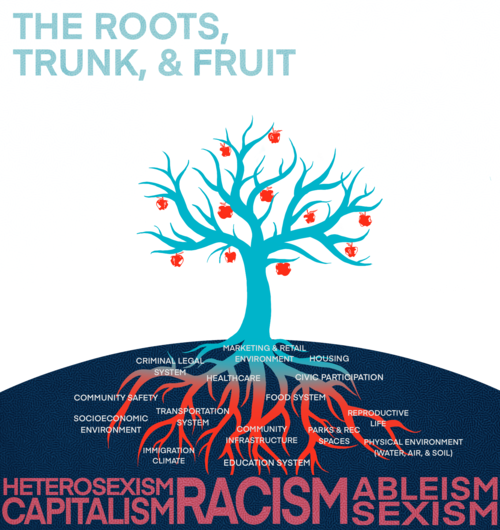
“This inequity within the roots leads to communities experiencing historical and ongoing oppression, or ‘the trunk.’ While the trunk and its branches are incredibly strong and resilient, the poor soil and its roots lead to a tree that bears impacted ‘fruit,’ or adverse health outcomes. While social determinants of health frameworks vary, the ultimate goal is to create the positive conditions in the roots for the tree to bear healthy fruit and thrive,” according to the Praxis Project’s website.
- Shovels and Uprooting
Using the shovels to uproot the tree symbolizes how the social determinants of health must be addressed at the root and overhauled.
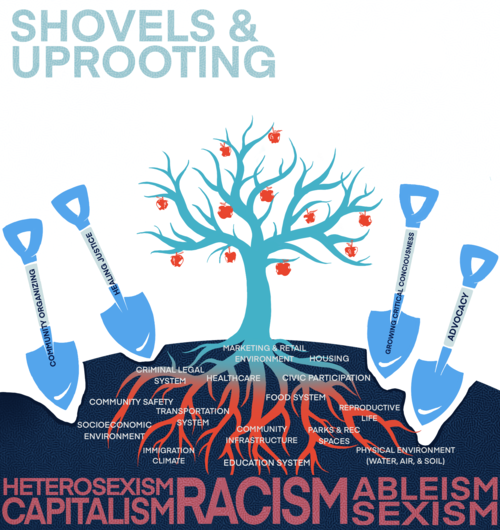
“To combat the adverse health outcomes seen in the impacted fruit, we must begin to remove the corrupted soil and heal the roots… This amounts to removing the fruit or cutting off a branch of the tree, leaving the roots and soil intact. Despite efforts and spending on healthcare in the U.S., health disparities within marginalized, historically oppressed communities have not improved. This shift can only happen, and our communities can only begin to thrive when we tackle inequity by going ‘upstream,’ going beyond simply looking at the social conditions that impact health, and by transforming the foundation of the tree—the soil and the roots,” according to the Praxis Project’s website.
- New Soil
The new soil represents polices and practices that create a more equitable society.
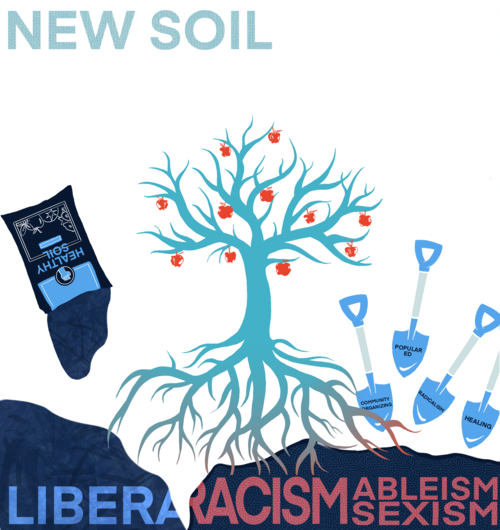
“In addition to uprooting the existing soil and removing systems of oppression, we must replant the tree in an entirely new, healthy soil. In other words, as we are dismantling and challenging the existing world order, we are also working towards building and imagining a new world that cultivates justice and liberation so that all communities may thrive,” according to the Praxis Project’s website.
- Healthy People and Community
Once the oppressive systems have been addressed, communities can flourish and be healthy.
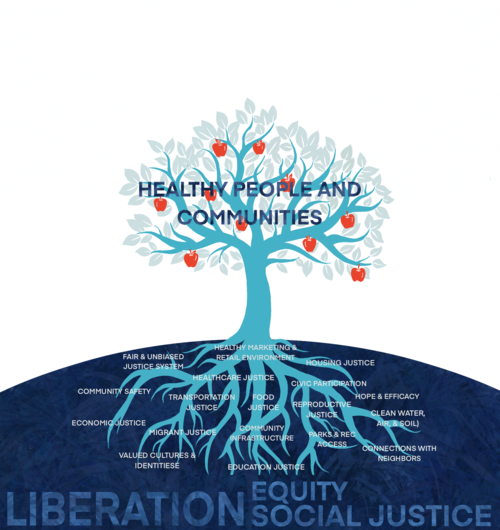
“Only once we have done the necessary work of dismantling systems of oppression and enacting a combination of policies and community approaches to develop a ‘healthy soil’ are we able to cultivate truly equitable and healthy people and communities,” according to the Praxis Project’s website.
How Do the Social Determinants of Health Affect Latinos?
Latinos experience many health disparities, often due to social determinants of health.
“The social determinants of health, such as access to healthcare, affordable housing, employment, and income, to name a few, are a bridge between social and environmental conditions affecting health outcomes,” according to Dr. Amelie G. Ramirez, director of Salud America! at UT Health San Antonio, and Drs. Rita Lepe and Francisco Ciagarroa of the Transplant Center at UT Health San Antonio, in a new article in the Journal of the American Medical Association (JAMA).
Past and present discriminatory policies and practices created inequities in social and environmental conditions and are to blame for many poor outcomes that Latinos experience today.
The COVID-19 pandemic worsened these deep-rooted inequities and pre-existing health disparities, as Latinos have suffered disproportionate case and death rates.
Some examples of disparities that Latinos experience are lack of access to healthy food and disproportionate economic and housing issues.
Latinos have less access to healthy food and places to safely practice physical activity:
- Latino neighborhoods have 1/3 as many supermarkets as non-Latino ones.
- Fewer Latinos (70%) than whites (82.5%) say their neighborhood has safe play spaces for kids.
- Latino infants were twice as likely to be fed sugary drinks than their non-Latino peers. Latino kids who consumed sugary drinks had 2.3x the odds of severe obesity.
Latinos face economic issues that put them at risk for poverty:
- Latino families are burdened by high housing costs, eviction, and displacement. The percentage of Latinos who are “housing cost burdened,” spending 30% or more of household income on housing costs, grew from 42.4% in 2000 to 56.9% in 2015.
- Latino families are more likely to live in poverty than white families. Child poverty rates are more than twice as high for Latino children than White children (23.7% vs 8.9%).
- Many Latinos lack health insurance. Despite the Affordable Care Act, the uninsured rate remains higher among Latino (25.1%) than White adults (8.5%).
Studies have also shown that Latinos perceive educational factors, economic factors, and racial discrimination to impact health, while white people are less likely to agree, according to a survey from the Episcopal Health Foundation (EHF).
The study measured Texans’ perception of factors contributing to health disparities:
- 74% of Latino and Black Texans believe economic factors directly impact health, compared to 47% of white Texans
- 66% of Latino and Black Texans believe educational factors directly impact health, compared to 53% of white Texans
- 56% of Black and Latino Texans believe racial discrimination factors directly impact health, 42% of white Texans
Not only do these issues concern people of color throughout the country, but they are causing them significant harm, according to Dr. Ramirez.
“Latino families are burdened by high housing costs, eviction, and displacement,” she writes in a Salud America! research review. “The percentage of Latinos who are ‘housing cost-burdened,’ spending 30% or more of household income on housing costs, grew from 42.4% in 2000 to 56.9% in 2015. More Latinos rent their homes (54%) than their White peers (28%). They also experience significantly higher rates of eviction and involuntary displacement.”
What Can You Do to Improve Health Equity for Latinos?
We can address the inequities caused by social determinants of health by fostering social cohesion and building community power.
“Social cohesion represents the capacity of a society to ensure the long-term physical and psychological well-being of its members. A cohesive society is an inclusive one; a society without significant disparities in health, wealth and income, one that values individuals’ backgrounds, integrating those from different backgrounds in such a way that everyone can relate to one another,” according to a Salud America! research review.
Unfortunately, social cohesion is on the decline in the U.S., due to increasing poverty and inequities.
We can help rebuild it through different social interactions.
“Social interaction with others does affect health outcomes, as relationships can facilitate the sharing of resources, help increase opportunities, and improve livelihood,” according to a Salud America! research review.
Building community power can also create systemic change.
“The connection between community-led strategies, place, and health is strong and research has shown that the people most directly affected by systemic barriers and inequities are best positioned to drive change in their communities,” according to RWJF.
You can also help address health disparities by assessing health equity in your own community.
Download a Salud America! Health Equity Report Card for your area.
The report card allows you to see what access your community has to healthcare, food, education, and other resources.
You can help advocate for your neighbors and present the Health Equity Report Card to your city’s leadership!
Get your Health Equity Report Card!
Explore More:
Understanding & Reducing PovertyBy The Numbers
23.7
percent
of Latino children are living in poverty



